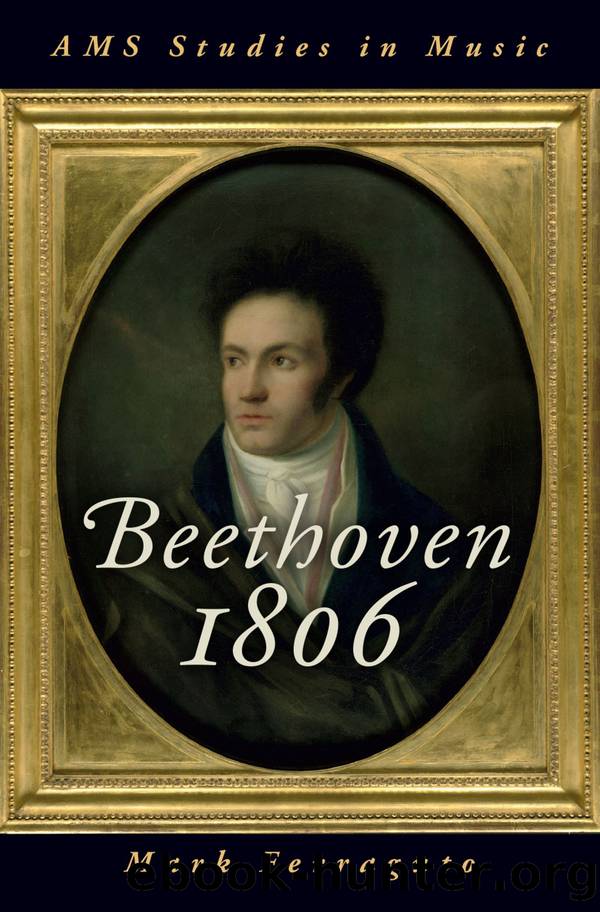Beethoven 1806 by Ferraguto Mark;

Author:Ferraguto, Mark;
Language: eng
Format: epub
Publisher: Oxford University Press, Incorporated
Published: 2019-06-15T00:00:00+00:00
Chapter 4
Music for a Culture Hero
Opus 60
As early as 1831, a British commentator noted that Beethovenâs Fourth Symphony was the âleast frequently brought forwardâ of the first six, though, he hastened to add, it was ânot inferior to any.â1 Seven years later, a French critic wrote that in Paris the âsublime symphony in B-flatâ had not only been neglected but was also routinely dismissed as âa work of folly, without true beauty and without meaning.â2 While the Fourth Symphony came to occupy a significant place on European concert programs in the later nineteenth century, it remained a seldom-performed work in many American concert halls through much of the twentieth. On the centennial of Beethovenâs death in 1927, the British conductor Sir Henry Wood was astonished to find that the Fourth Symphony had never before been heard in Los Angeles: âThink of so attractive a work having been almost entirely neglected. I put in that âalmost,â because it appeared that some conductors had gone as far as rehearsing it. But when the pinch came their courage failed, and down went No. 5 instead!â3
Woodâs account highlights the discomfort this symphony has often caused for performers, critics, and even audiences. Indeed, the symphonyâs reception history is a tale of apologias and rescue attemptsâas one critic opined, the Fourth Symphony has been subject to âmore misrepresentation than any other work by Beethoven.â4 Lacking descriptive titles and other extramusical signifiers, it posed a problem for nineteenth-century critics applying programmatic modes of analysis to Beethovenâs music, leading Alexandre Oulibicheff, in 1857, to label it the âbête noireâ of Beethoven criticism.5 More recently, its aesthetic has been viewed as incongruent with that of Beethovenâs âheroic style,â a critical paradigm that has inspired an extraordinary proliferation of scholarship on the mature odd-numbered symphonies and, for more complicated reasons, the Pastoral, but has tended to marginalize the others. And yet the Fourth is by no means a neglected work today. According to the League of American Orchestras, the symphony received over two hundred performances by major American orchestras in the first decade of the twenty-first century; in the 2007â8 season (two centuries after its Viennese premiere in 1807), it was among the twenty most frequently programmed orchestral works in the country.6
One aspect of the Fourth Symphony that has garnered critical attention is its apparent indebtedness to Haydn and, to a lesser extent, Mozart. Scholars have attributed this indebtedness to a number of musical features: it begins with a âHaydnesqueâ slow introduction rather than in medias res; its codas are short and to the point, not expansive and dramatic; its textures and forms are relatively transparent; it concludes with a light, even comic, finale rather than a transcendent, weighty one; and it requires no additional instruments beyond the standard complement of the late eighteenth century (and only one flute). Donald Francis Tovey has suggested further points of contact: in the first movement, for instance, Beethoven handles rhythm in such a way that âMozartâs own freedom of movement reappears as one of the most striking qualities of the whole.
Download
This site does not store any files on its server. We only index and link to content provided by other sites. Please contact the content providers to delete copyright contents if any and email us, we'll remove relevant links or contents immediately.
The Goal (Off-Campus #4) by Elle Kennedy(13209)
Kathy Andrews Collection by Kathy Andrews(11342)
Diary of a Player by Brad Paisley(7271)
What Does This Button Do? by Bruce Dickinson(5937)
Assassin’s Fate by Robin Hobb(5866)
Big Little Lies by Liane Moriarty(5526)
Altered Sensations by David Pantalony(4872)
Pale Blue Dot by Carl Sagan(4630)
Sticky Fingers by Joe Hagan(3916)
The Death of the Heart by Elizabeth Bowen(3345)
The Heroin Diaries by Nikki Sixx(3327)
Beneath These Shadows by Meghan March(3156)
Confessions of a Video Vixen by Karrine Steffans(3106)
The Help by Kathryn Stockett(3023)
How Music Works by David Byrne(2969)
Jam by Jam (epub)(2882)
Harry Potter 4 - Harry Potter and The Goblet of Fire by J.K.Rowling(2816)
Strange Fascination: David Bowie: The Definitive Story by David Buckley(2703)
Petty: The Biography by Warren Zanes(2578)
